The Effects of Zoning Regulations along Fault Zone Areas on Land Development and Property Values after the 921 Chi-Chi Earthquake in Taiwan
Abstract
:1. Introduction
2. Data and Methodology
2.1. Study Area
2.2. Data Description
2.2.1. Land Use Change Data
2.2.2. Property Transaction Data
2.3. Spatial Autocorrelation Coefficient
3. Results
3.1. Spatial Characteristics of Land Use Change
3.1.1. Land Use Change from 1995 to 2008
3.1.2. Land Use Change from 2008 to 2014
3.2. Spatial Characteristics of Property Transaction Values
4. Discussion
5. Conclusions
Acknowledgments
Author Contributions
Conflicts of Interest
References
- O’Brien, K.; Sygna, L.; Leichenko, R.; Adger, W.N.; Barnett, J.; Mitchell, T.; Schipper, L.; Tanner, T.; Vogel, C.; Mortreux, C. Disaster reduction, climate change adaptation and human security. In Global Environmental Change and Human Security; The MIT Press: Cambridge, MA, USA, 2008. [Google Scholar]
- Guha-Sapir, D.V. Earthquakes, an epidemiological perspective on patterns and trends. In Human Casualties in Earthquakes: Progress in Modelling and Mitigation; Springer: Dordrecht, The Netherlands, 2010. [Google Scholar]
- Sheaffer and Roland, Inc. Flood Hazard Mitigation through Safe Land Use and Construction Practices; Keifer and Associates, Inc.: Chicago, IL, USA, 1976. [Google Scholar]
- Petak, W.J.; Atkisson, A.A. Natural Hazard Risk Assessment and Public Policy: Anticipating for Unexpected; Springer-Verlag: New York, NY, USA, 1982. [Google Scholar]
- Kerr, J.; Nathan, S.; Van Dissen, R.J.; Webb, P.; Brunsdon, D.; King, A.B. Planning for Development of Land on or Close to Active Faults: An Interim Guideline to Assist Resource Management Planners in New Zealand; GNS Client Report; Ministry for the Environment: Wellington, New Zealand, 2003.
- Center for Disaster Management (CENDIM); Bogazici University; the Center for Hazards and Risk Research (CHRR); Columbia University. Urban Risk Management or National Disasters: A Research Planning Workshop; CENDIM: Istanbul, Turkey, 2001. [Google Scholar]
- Coburn, A.; Spence, R. Earthquake Protection; John Wiley & Sons: Chichester, UK, 2002. [Google Scholar]
- Athanasopoulou, E.; Despoiniadou, V.; Dritsos, S. The impact of earthquakes on the city of Aigio in Greece. Urban planning as a factor in mitigating seismic damage. In Proceedings of the Seismic Engineering Conference Commemorating the 1908 Messina and Reggio Calabria Earthquake, Reggio Calabria, Italy, 8–11 July 2008. [Google Scholar]
- Bolton, P.A.; Heikkala, S.; Greene, M.; May, P.; Wolfe, M.R. Land Use Planning for Earthquake Hazard Mitigation: A Handbook for Planners. Paper 82. Available online: http://scholarcommons.usf.edu/fmhi_pub/82 (accessed on 25 February 2017).
- Brookshire, D.S.; Thayer, M.A.; Tschirhart, J.; Schulze, W.D. A test of the expected utility model: Evidence from earthquake risks. J. Political Econ. 1985, 93, 369–389. [Google Scholar] [CrossRef]
- Dale-Johnson, D.; Hyang, K.Y. Coastal development moratoria and housing prices. J. Prop. Financ. Econ. 1990, 3, 165–184. [Google Scholar] [CrossRef]
- Bernknopf, R.; Brookshire, D.S.; Thayer, M. Earthquake and volcano alerts: An economic evaluation of risk perception changes. J. Environ. Econ. Manag. 1990, 18, 35–49. [Google Scholar] [CrossRef]
- McGinnis, A. The Effect of Earthquake Risk on San Francisco Bay Area Housing Market: How Has It Changed Since the Loma Prieta and Northridge Earthquake? Ph.D. Thesis, Standford University, Standford, CA, USA, 2004. [Google Scholar]
- Nakagawa, M.; Saito, M.; Yamaga, H. Earthquake risks and land prices: Evidence from the Tokyo metropolitan area. Jpn. Econ. Rev. 2009, 60, 208–222. [Google Scholar] [CrossRef]
- Zhang, Y.; Hwang, S.N.; Lindell, M.K. Hazard proximity or riskperception? Evaluating effects of natural and technological hazards on housing values. Environ. Behav. 2010, 42, 597–624. [Google Scholar] [CrossRef]
- Palm, R. Real Estate Agents and Special studies Zones Disclosure: The Response of California Home Buyers to Earthquake Hazards Information; Institute of Behavioral Science, Program on Technology, Environment and Man, Monograph No. 32; University of Colorado: Boulder, CO, USA, 1981. [Google Scholar]
- Toké, N.A.; Boone, C.G.; Arrowsmith, J.R. Fault zone regulation, seismic hazard, and social vulnerability in Los Angeles, California: Hazard or urban amenity? Earth’s Futur. 2014, 2, 440–457. [Google Scholar] [CrossRef]
- Tobler, W.R. A computer movie simulating urban growth in the Detroit region. Econ. Geogr. 1970, 46, 234–240. [Google Scholar] [CrossRef]
- Cliff, A.D.; Ord, J.K. Spatial Processes; Pion: London, UK, 1981. [Google Scholar]
- Goodchild, M.F. Spatial Autocorrelation; CATMOG 47; University of East Angolia: Norwich, UK, 1986. [Google Scholar]
- Griffith, D.A. Spatial Autocorrelation and Spatial Filtering: Gaining Understanding through Theory and Scientific Visualization; Springer-Verlag: Berlin/Heidelberg, Germany, 2003. [Google Scholar]
- Wong, D.W.S.; Lee, J. Statistical Analysis of Geographic Information with ArcView GIS and ArcGIS; Wiley: Chichester, UK, 2008. [Google Scholar]
- Chang, H.S.; Chen, T.L. Exploring spatial patterns of farmland transactions and farmland use changes. Environ. Monit. Assess. 2015, 187, 1–14. [Google Scholar] [CrossRef] [PubMed]
- Bivand, R.S. Exploratory spatial data analysis. In Handbook of Applied Spatial Analysis: Software Tools, Methods and Applications; Springer: Heidelberg, Germany; Dordrecht, The Netherlands; London, UK; New York, NY, USA, 2010. [Google Scholar]
- Anselin, L. Local indicators of spatial association-LISA. Geogr. Anal. 1995, 27, 93–116. [Google Scholar] [CrossRef]
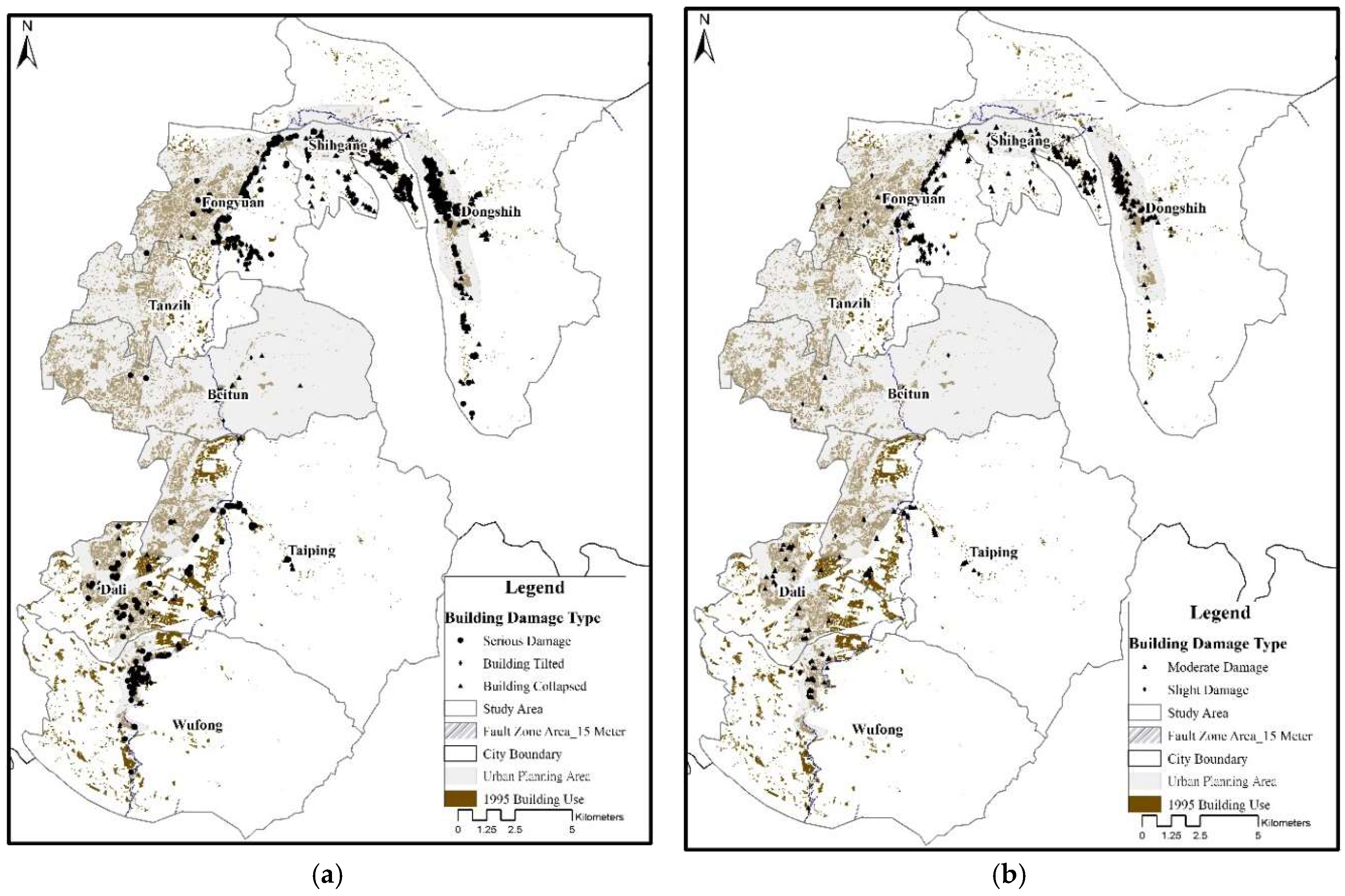
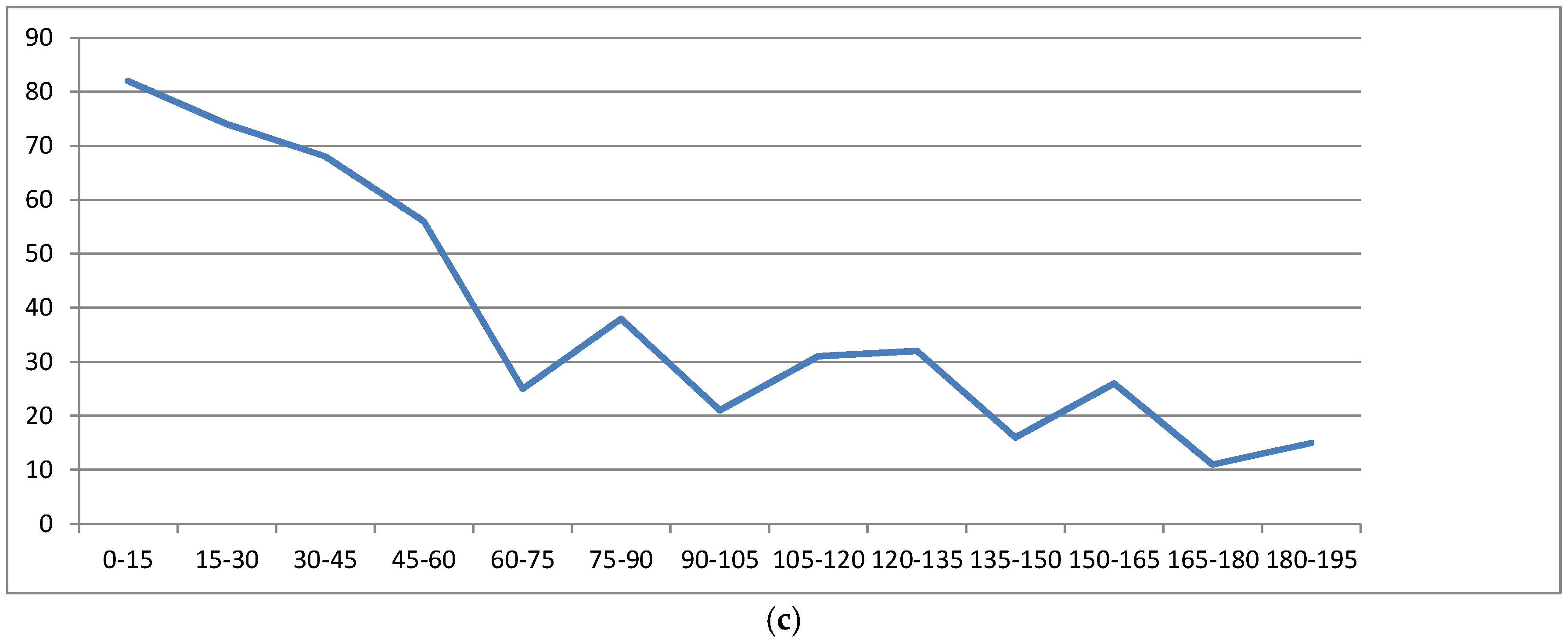
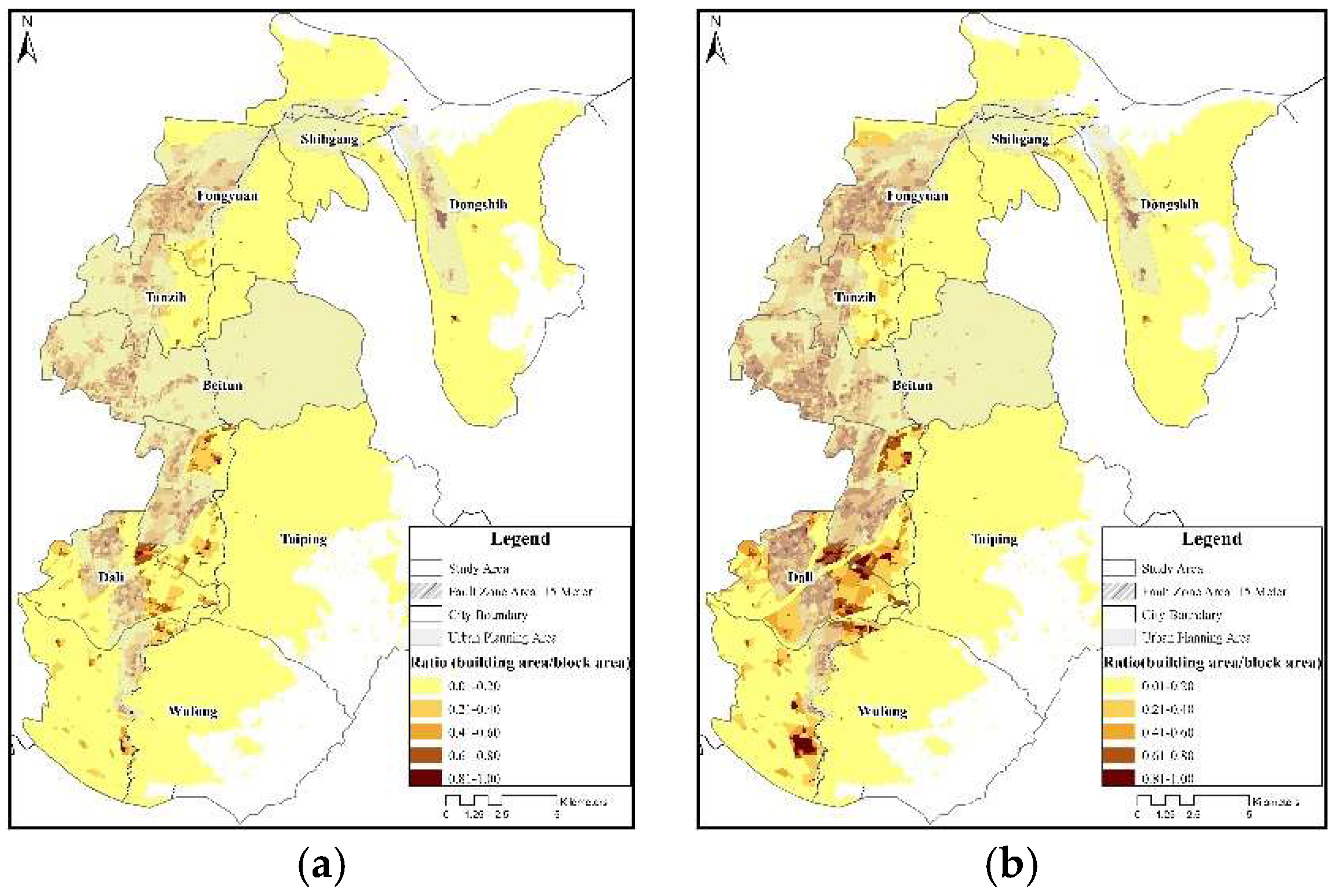
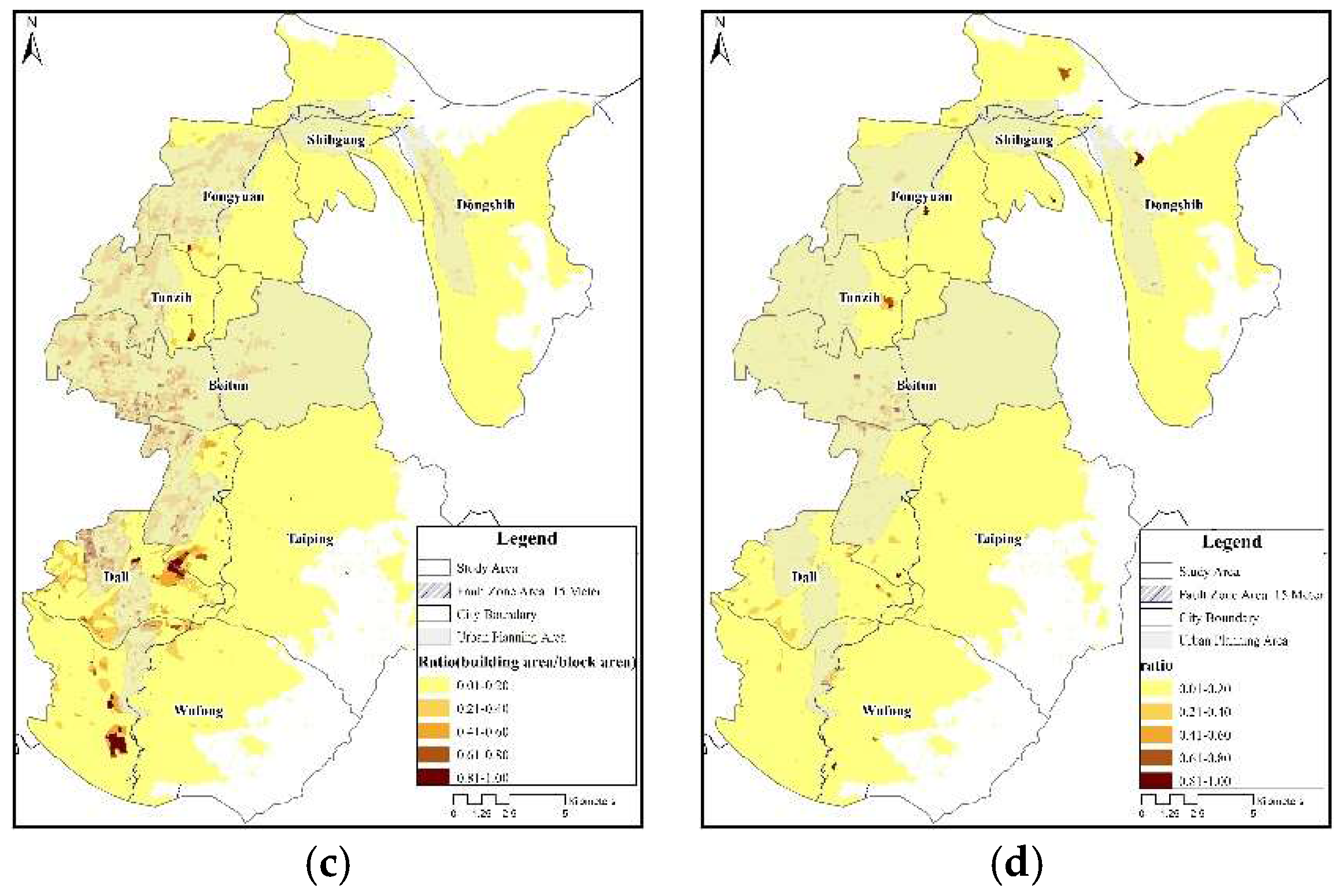
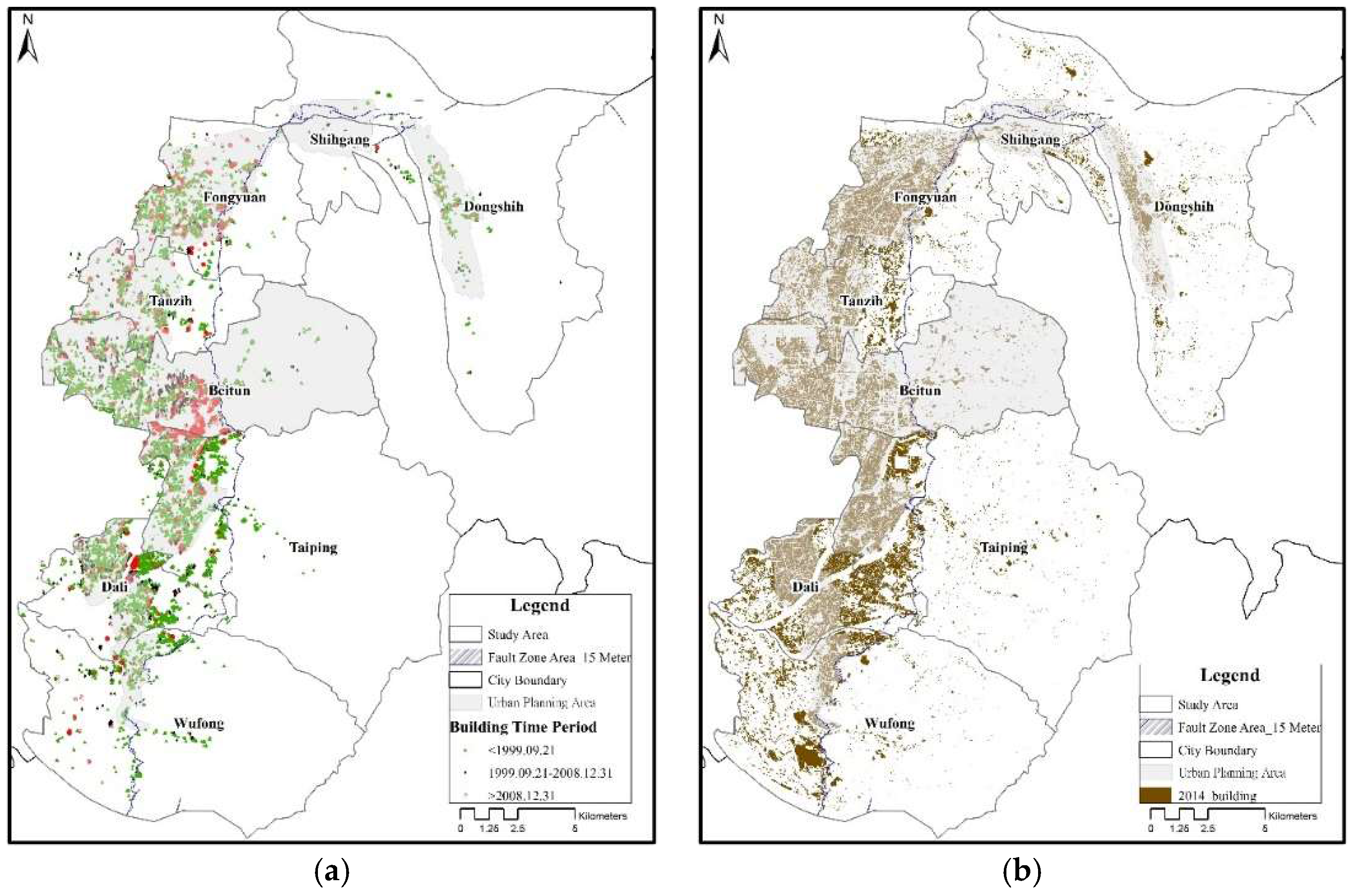
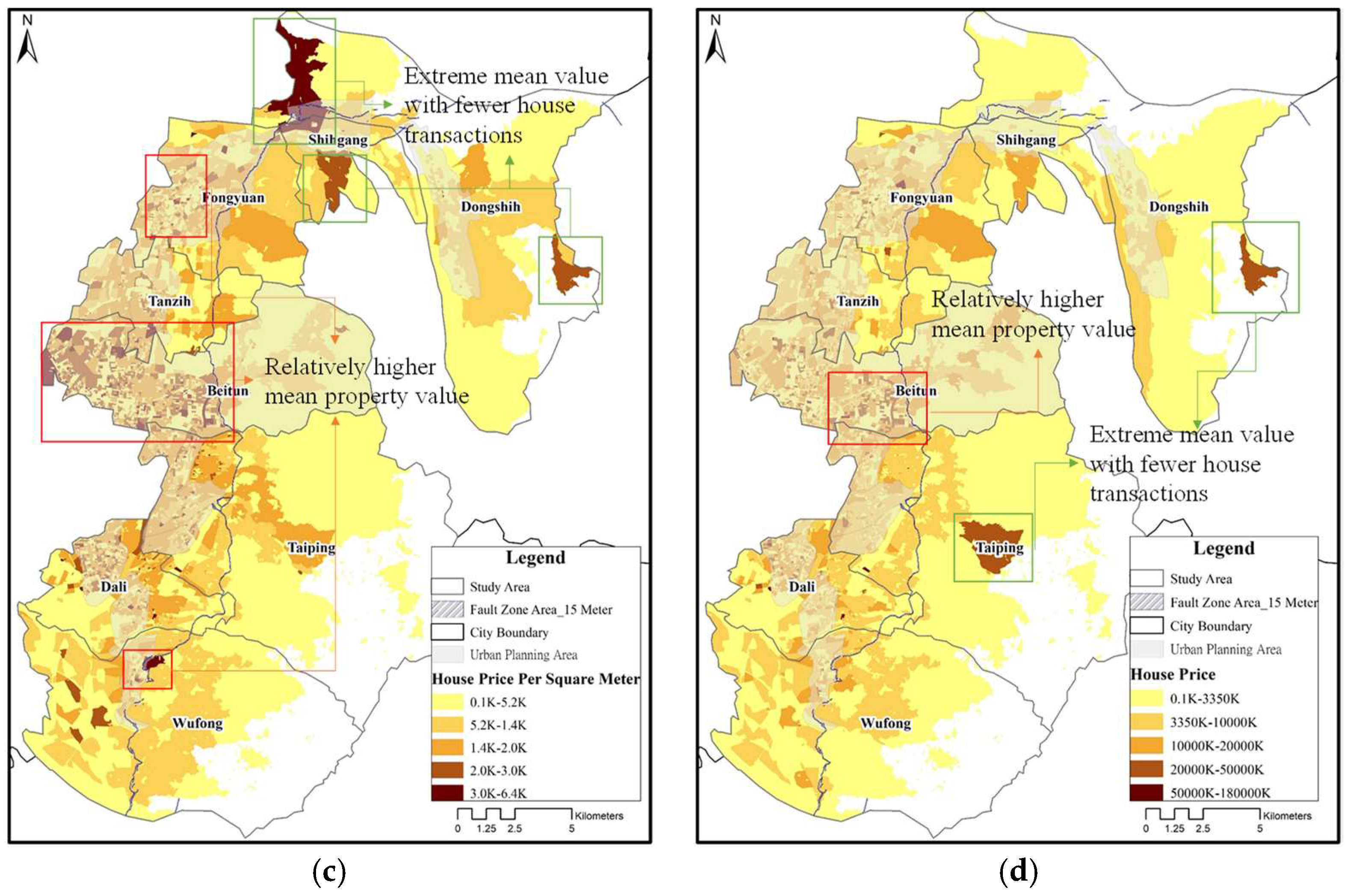

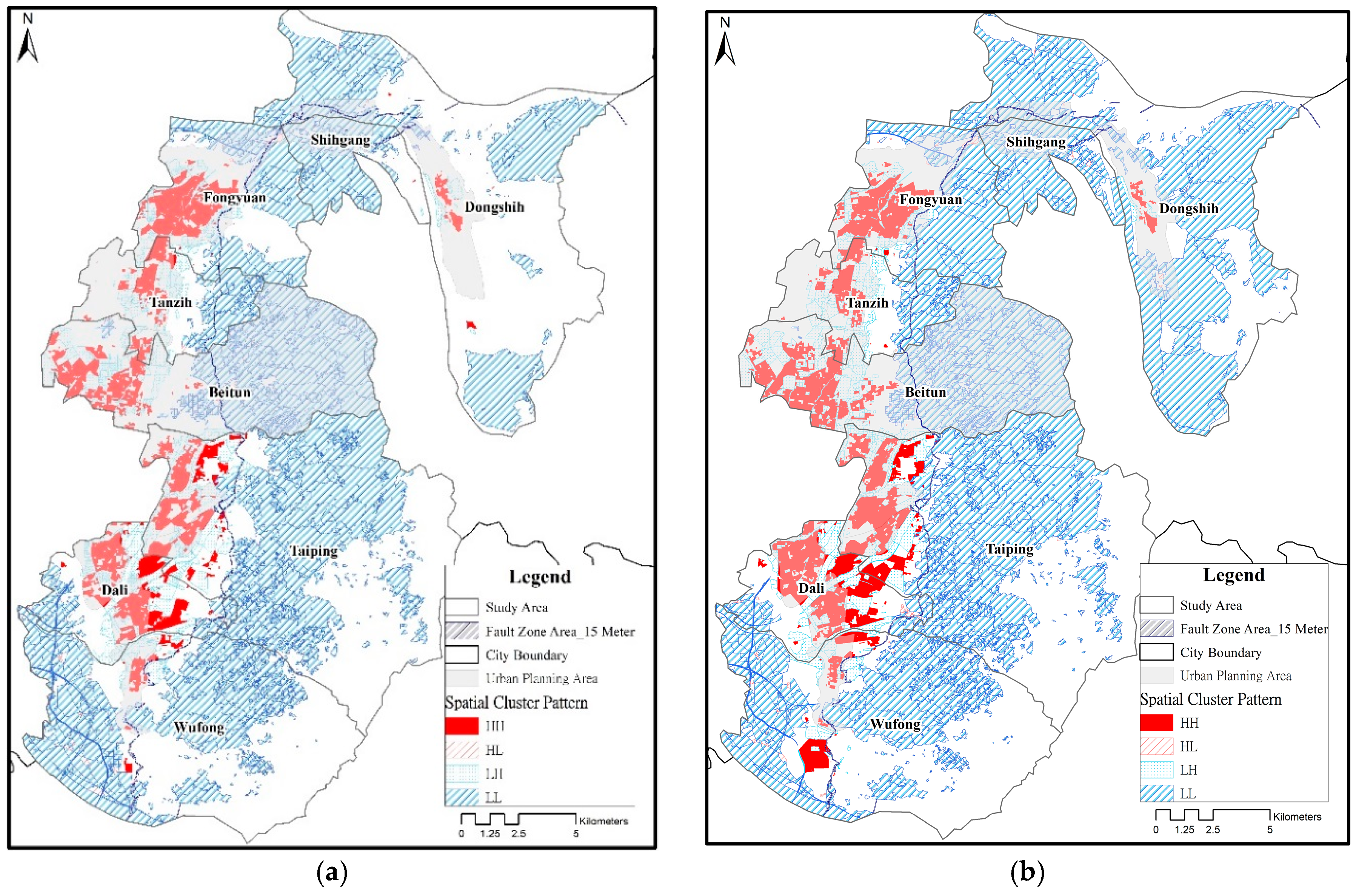
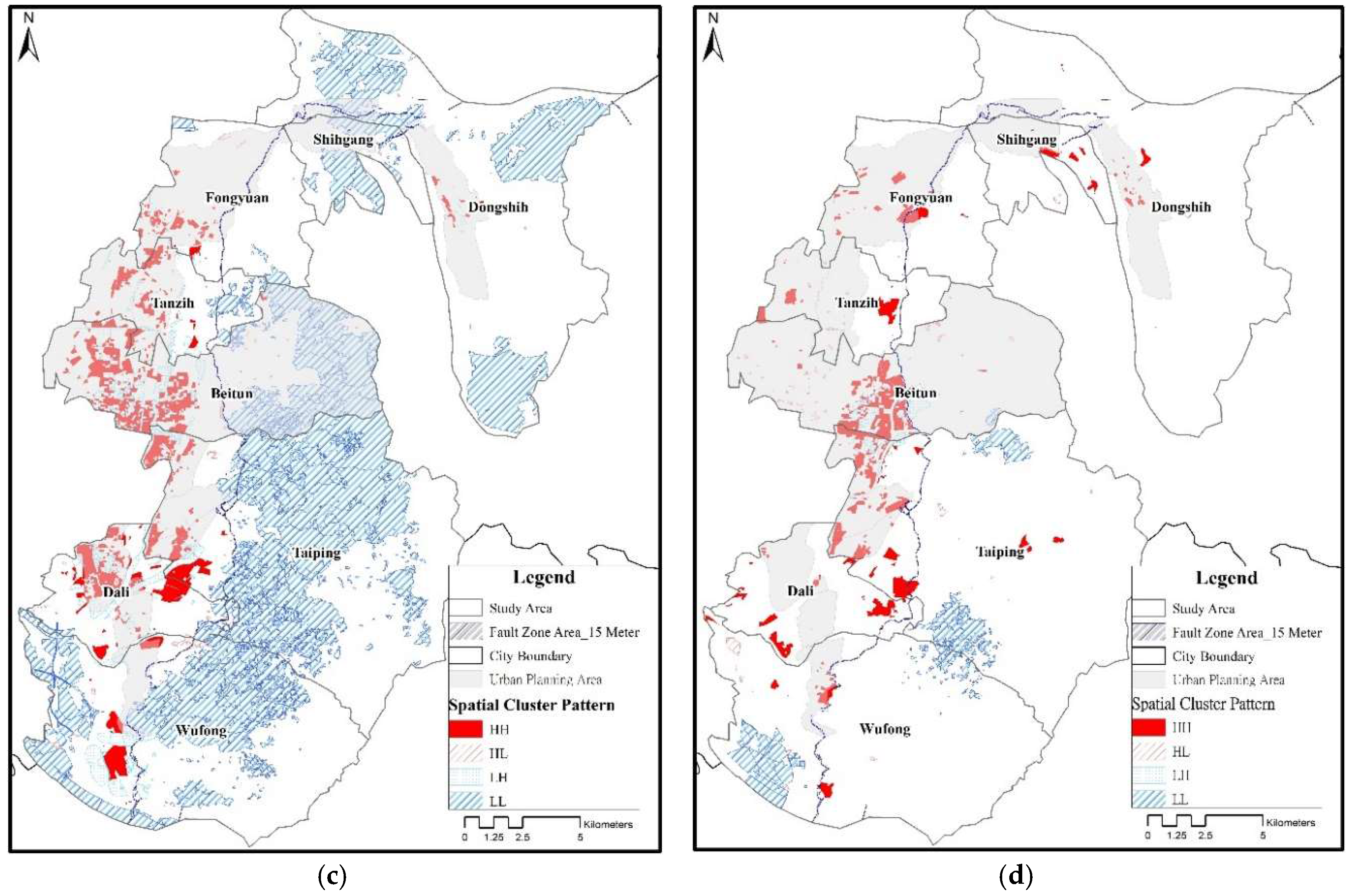
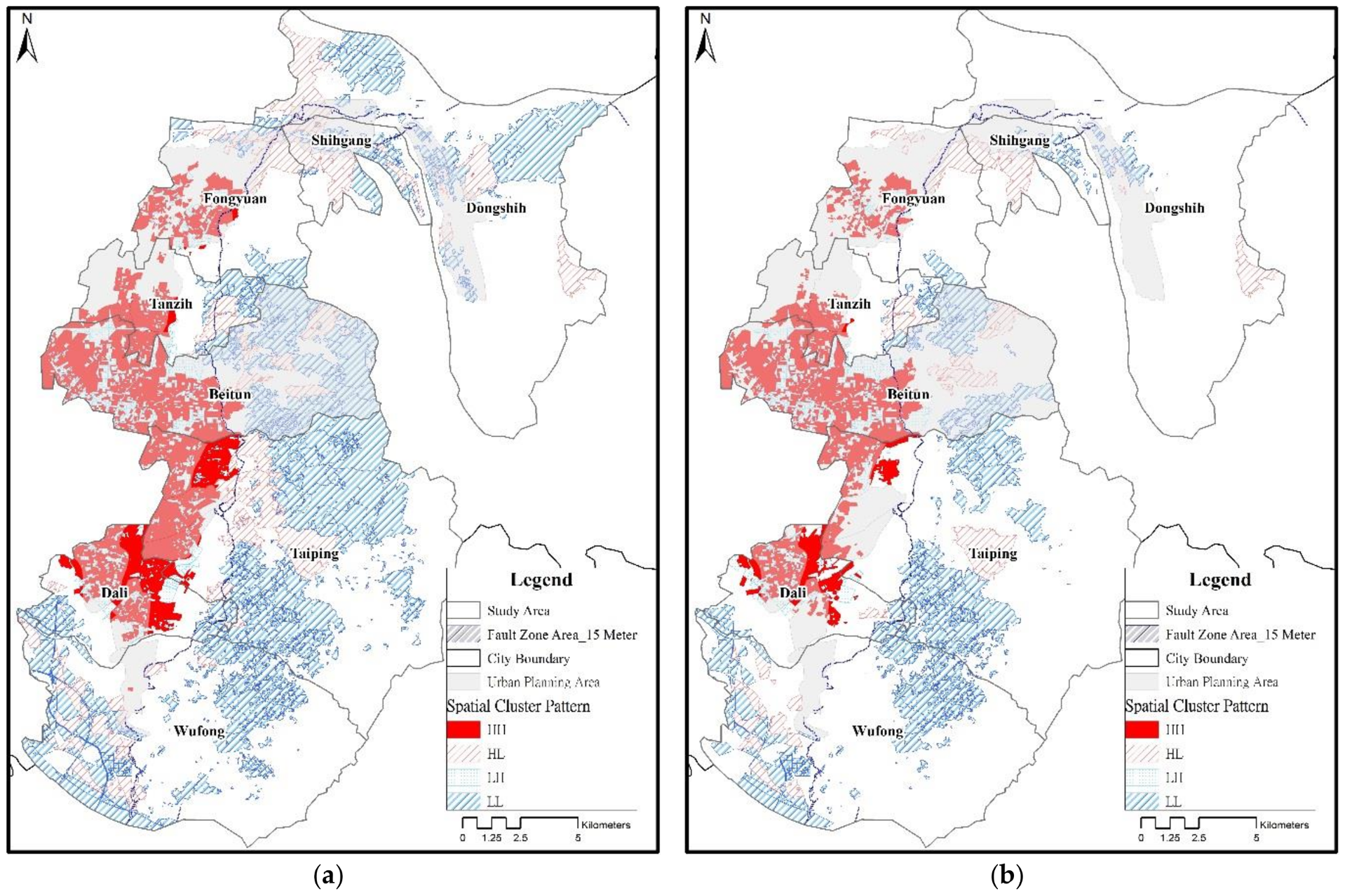
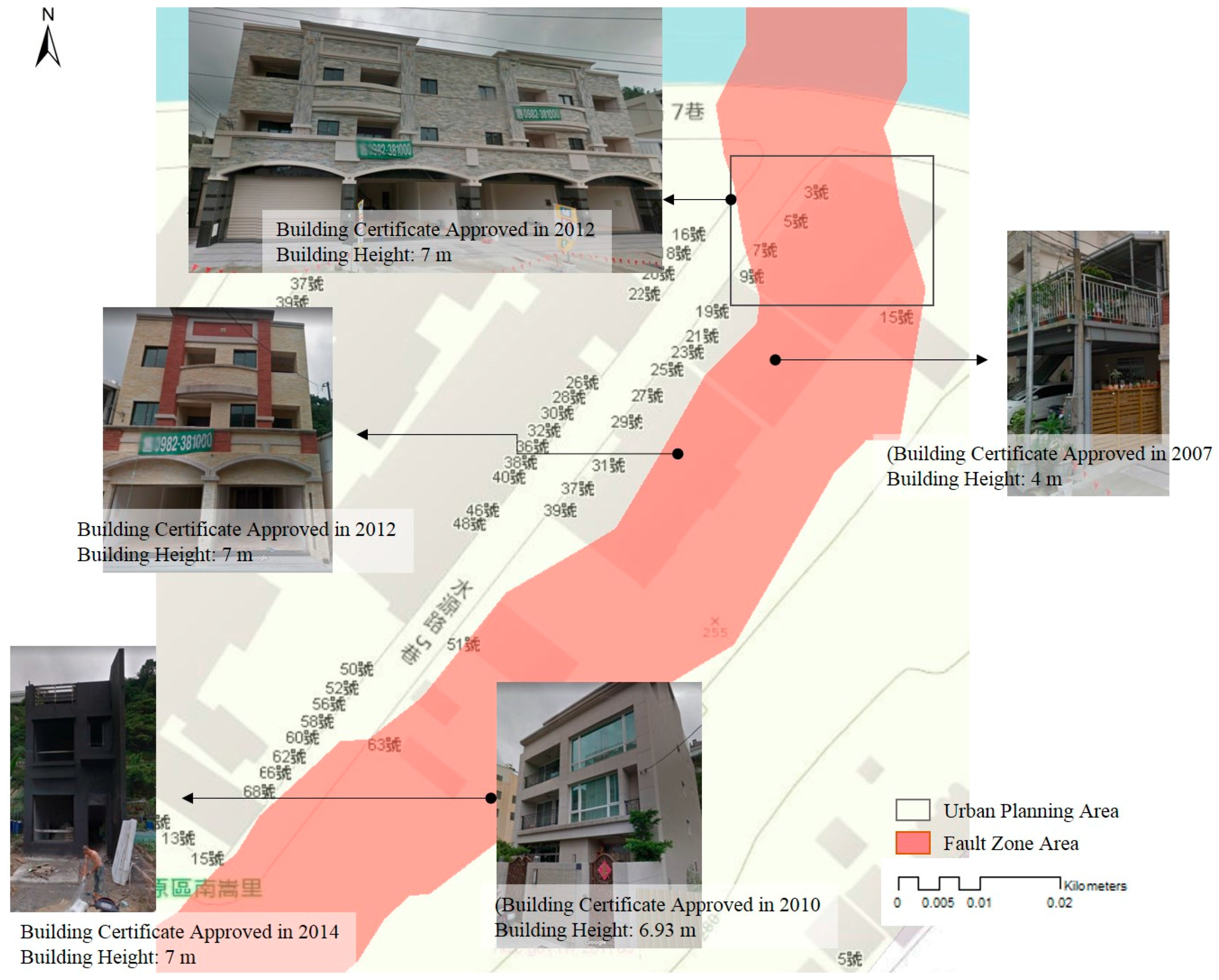
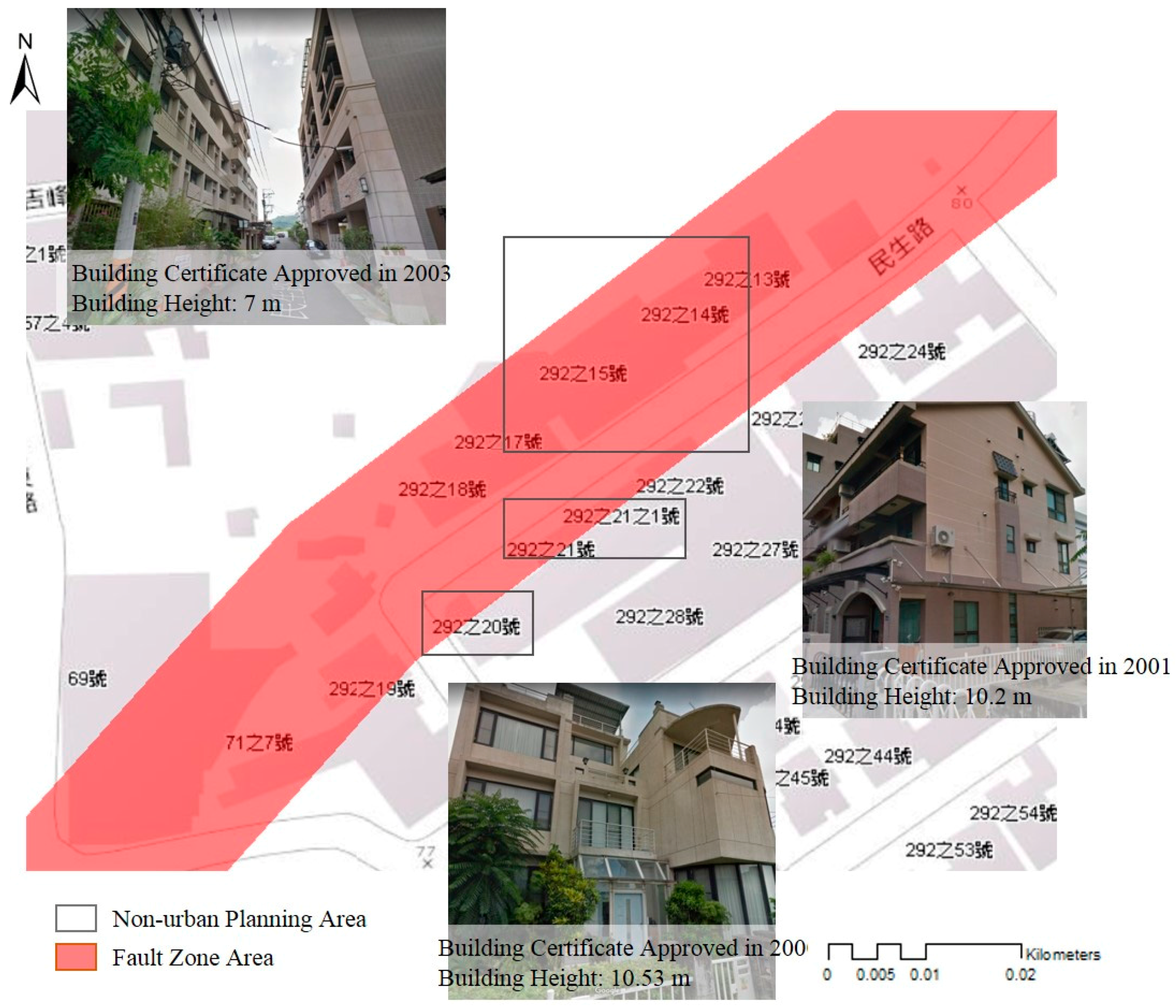
| Spatial Patterns | Geary’s Ratio | Moran’s I Index |
|---|---|---|
| Clustered pattern in which adjacent or nearby blocks show similar characteristics | 0 < C < 1 | I > E(I) |
| Random pattern in which blocks do not show particular patterns of similarity | ||
| Dispersed pattern in which adjacent or nearby blocks show different characteristics | 1 < C < 2 | I < E(I) |
| Moran’s I Index | E(I) | Z-Scores | Pattern | ||
|---|---|---|---|---|---|
| Continue building use | 1995–2008 | 0.3524 | −0.0001 | 252.5748 | Clustered |
| 2008–2014 | 0.4055 | 290.6210 | Clustered | ||
| Become building use | 1995–2008 | 0.2006 | 143.8835 | Clustered | |
| 2008–2014 | 0.0914 | 65.6674 | Clustered | ||
| Moran’s I Index | E(I) | Z-Scores | Pattern | ||
|---|---|---|---|---|---|
| Property transaction | Per square meter | 0.2269 | −0.0001 | 154.7625 | Clustered |
| House price | 0.1724 | 118.2155 | Clustered | ||
© 2018 by the authors. Licensee MDPI, Basel, Switzerland. This article is an open access article distributed under the terms and conditions of the Creative Commons Attribution (CC BY) license (http://creativecommons.org/licenses/by/4.0/).
Share and Cite
Chen, T.-L.; Chang, H.-S. The Effects of Zoning Regulations along Fault Zone Areas on Land Development and Property Values after the 921 Chi-Chi Earthquake in Taiwan. Sustainability 2018, 10, 1175. https://doi.org/10.3390/su10041175
Chen T-L, Chang H-S. The Effects of Zoning Regulations along Fault Zone Areas on Land Development and Property Values after the 921 Chi-Chi Earthquake in Taiwan. Sustainability. 2018; 10(4):1175. https://doi.org/10.3390/su10041175
Chicago/Turabian StyleChen, Tzu-Ling, and Hsueh-Sheng Chang. 2018. "The Effects of Zoning Regulations along Fault Zone Areas on Land Development and Property Values after the 921 Chi-Chi Earthquake in Taiwan" Sustainability 10, no. 4: 1175. https://doi.org/10.3390/su10041175
APA StyleChen, T.-L., & Chang, H.-S. (2018). The Effects of Zoning Regulations along Fault Zone Areas on Land Development and Property Values after the 921 Chi-Chi Earthquake in Taiwan. Sustainability, 10(4), 1175. https://doi.org/10.3390/su10041175





